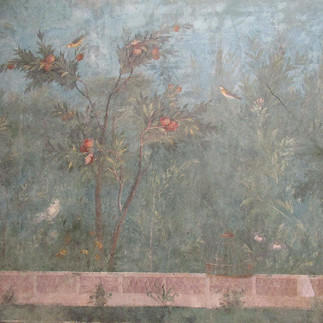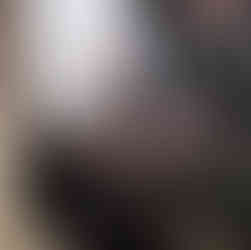Betwixtmas Reflection -- 2023 in Review, Part 1: Spinning, Weaving, Textiles & History
- cdfleiner
- Dec 29, 2023
- 4 min read
That dreamy nothing week between Christmas and New Years is the best -- downtime from the real world, a chance to catch up on projects, and to have a tidy, clear-out, and plan for the next year.
Highlights for 2023 included heritage site demos of textile crafts, workshops taught, and workshops taken.
January 2023 was all about Rome: a productive stay at the BSR where I worked on the draft of a book chapter (part of a collection about the rule of the Carolingians in the southern parts of their kingdom), but also a chance to poke around in the museums in the capit mundi as well as the flea markets.
I looked for patterns and designs on this trip, as you can see in these marble tiles from the House of Augustus on the Palatine Hill, a section of a floor from Nero's Domus Transitoria, and the beautiful reflections of a bridge over the Tiber, as seen from Milvian Bridge.
I like to wander the streets, especially around the Campus Martius, and came across a high-end department store which had an antique spinning wheel in its front window -- the manager of the shop was kind enough to let me photograph it but could not be convinced that the wheel was not assembled correctly.

My immediate view next to my desk in the library was of a lemon tree whose colours, leaves, and fruits became the inspiration for a knitted hat.
The flea markets were great fun and yielded lovely results. Amongst other goodies, I found a bone, jade, and coral needle Georgian-era case, a tiny pair of silver scissors, and a 19th-century silver stiletto.
Rome is full of patterns and textures. These delicate paintings are all housed in the Palazoo Massimo.
#rome #ancientrome #romanempire #spinning #weaving #pattern #design #textiles #history #ancienthistory
February was all about colour and cotton.
First, the Cricket was loaded up with handspun yarn that had been dyed with koolade in the sun the summer before. This woolen piece was turned into a squashy pillow.

Cotton spun up on the charka was turned into a long throw, supervised here by Tiny Toast, This one took forever as the cotton warp was constantly shredding on me.

Speaking of Tiny, the slow progress of spinning up her fur on the charka continued.

She also modelled two yew dizzes made for me by my father-in-law. The wood for these tools is around 700 years old, as the wood came from branches fallen from the churchyard in a small village in Kent where his family live.

Finally, this month included a lively nalbinding workshop that I ran at the Ashcroft Arts Centre in Fareham, Hampshire.

March 2023 started out with a handful of 19th-century French spindles. There were about ten of them in the bundle -- two have become essentials tools in my workbox. At least one of them is haunted.

I acquired a Bosworth Journey Wheel late in 2022, and by this point in the spring I'd got it up and running with some help from the Bosworths. It's one of their earliest models from 1977. The whole thing folds up into a lovely cherry-wood box.

Two talks this month: the first was back again at the Ashcroft Centre for a talk and demo of basic spinning history and techniques.

And then a return visit to the Isle of Wight -- always a pleasure to speak with the Historical Society Branch out on in the Island! Well-attended and with a lively Q & A.

#romanhistory #ancientrome #romanbritain #isleofwight #spinning #womenshistory #womeninhistory #spinningwheel #spindles #wool #cotton #textiles.
April 2023 was a season of learning and planting.
Flax seeds were procured for three beds: two small ones (one as part of a project for Let's Grow Flax) and an ambitious 25 sq foot bed which sadly perished probably due to its proximity to the allotment neighbour who uses what appears to be Agent Orange on his weeds.

I took an advanced nalbinding workshop at the Weald and Downland Museum near Chichester with Sally Pointer -- this one was all about making Roman-style socks.
This was followed up with a playdate at the British Museum to study the two nalbinding socks in their collection. Both are child-sized and date from between the 1st and 4th centuries AD. They are from Egypt and would have been cuddly and soft when new, but are now very fragile and brittle. The colours are true, a natural brown, and a vividly coloured, stripey sock with the remains of a lacing. Photos with the permission of the Trustees of the British Museum, for study purposes only.


The month ended with a trip out to the United States - also textiletastic. We took a trip to DC to visit the Textile Museum in Georgetown.

Frederick, Maryland, where I stayed, had on an exhibition of quilts and dresses at the Museum of Frederick County History.
Frederick is also the adopted home of Claire McCardell, who was part of the revolution in design of women's clothing after WWII -- if you are happy to have pockets in your dresses, this is your patron saint.

We also have a friend there who runs Venus on the Half Shell, which is a fabulous vintage shope. Her late partner collected interesting vintage clothing and artwork, including this duck canvas shirt from the late 1920s. It was a tradition for high school seniors to autograph and decorate their friends' shirts, and this is a masterpiece and time capsule of slang, cartoons, and culture of teenage life in Frederick, Maryland.
I stayed for a few days in Delaware with a friend who has been collecting textiles for many years now.

And finally, at the Frederick Fibre Fest, I hooked up with the great folks who are part of Njörðr's Wanderers, a very active Viking-era re-enactment group. Seen here is Diana Buck with her warp-weighted loom.

#spinning #weaving #quilting #history #historicalreenactment #frederickmaryland #fashion #vintagefashion #fashionhistory #nalbing #flax #linen #textiles
Stay tuned for part 2, May - August 2024.














































Comments